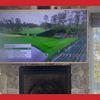How to Mount a TV on Drywall, Stucco, and Plaster

There are many reasons to install a TV in your home, or even on your covered patio, but if you’re unsure of how to secure such a heavy object to your wall, especially as surface treatments vary from home to home, this guide is for you.
It is possible to anchor a TV wall mount to any type of surface; you just need the right tools to ensure your system is installed properly and that your wall can handle the weight of your television.
Mounting a TV on Plaster Walls vs. How to Hang a TV Wall Mount on Drywall
The biggest difference you’ll discover between mounting a TV on plaster walls vs. hanging one over sheetrock are finding the studs.
Keep reading to learn how to locate the studs behind each wall, what to do if you don’t see them, and which anchors to use for a TV mount on plaster vs. drywall.
Plaster Wall TV Mounts
Before doing anything, understand what material was used to construct your home. Sometimes plaster is placed over brick and sometimes it’s placed over lath (narrow boards hung horizontally over the studs).
When you screw into a plaster wall, you could be hitting plaster, lath, and a stud, or plaster and brick. This is critical to know so you use the right type of anchor. To find this out, try knocking on the wall. When you knock on the plaster, does it sound solid or hollow? Brick will sound more solid while lath will sound more hollow.
In this section, we will primarily address how to hang your system to plaster and lath. For plaster-brick walls, please refer to our article, “How to Mount a TV on a Brick Wall.”
Step 1: Locate the Studs
While there are ways to hang a TV wall mount without a stud, we recommend fastening to a stud whenever possible to ensure it is the most secure. To locate studs behind plaster, you will need a strong magnet that you can drag along the wall to find them. The magnet will be able to detect where nails were used to attach the wood lath to the studs.
If you have trouble, locate your electrical outlets for the room. These boxes are attached to studs. Drag your magnet back and forth above the outlet box to determine if the stud is located to the left or right.
From there, measure out 16-24 inches, as is typical of stud spacing in home construction, to determine where the next post is located. You can use your magnet in this next area to verify the stud is there.
Step 2: Drill the Initial Holes
Once you have located your studs, drill a pilot hole through the plaster and into the wood. If you cannot locate the stud, drill your initial holes where you want the TV to hang. Plaster is very thick and can crack more easily, so be careful as you drill.
Step 3: Secure the TV Wall Mount Using Lag, Toggle, or Molly Bolts
For anchoring to studs behind plaster and lath, use lag bolts. If you are connecting your TV to a plaster wall without a stud, use a toggle or molly bolt, keeping in mind that a molly bolt can hold up to 50 pounds.
Keep in mind that when purchasing and using a MantelMount TV mount, they must be mounted to studs or a structural part of the wall and cannot be mounted to simply just drywall or plaster.
Drywall TV Mounts
Drywall is the most common building material homeowners encounter when placing their TV. For it, follow the steps listed below.
Step 1: Locate the Studs
There are a lot of great stud finders on the market these days. Having one in your home is helpful for hanging anything — from TVs to light fixtures and more. Use your stud finder to locate the posts.
If you have trouble or do not want to purchase a stud finder, you can use a similar method mentioned in the previous section: measuring along the wall from your outlets. While there is likely some metal used along these studs, you can also gently knock along the wall to verify a post is there. If it sounds hollow, you’re knocking on drywall. If it sounds solid, you’ve hit a stud.
Step 2: Drill the Initial Holes
This will be most important if you have found the stud, as it will make it easier for the screw to attach to the wood.
Step 3: Secure the TV Wall Mount Using Lag, Toggle, or Molly Bolts
For drywall, lag bolts are the best anchors to screw into studs. For positioning without a stud, use toggle or molly bolts. Because this material is much thinner than others you might screw into, we highly recommend attaching your mount to at least one stud for additional stability.
If that’s not possible, consider using our SSB40 Single Stud Wall Adapter, as it serves as a replacement for the included mounting wall plate when it can’t reach an existing stud placement. This will help carry the weight of the TV with more ease and give you more places to add anchors for a sturdy mount.
Can You Put a TV Mount on Stucco?
If you love spending time outside or hosting events, you may want to install one of our WeatherMounts on your covered patio. In doing so, you may encounter uneven stone or stucco. Since we have already addressed how to attach a TV to uneven stone surfaces, we wanted to share instructions for hanging a TV on stucco.
The first thing you’ll want to do before securing anything to stucco is determine if the stucco is covering wood or concrete. To test, knock and see if it sounds hollow or solid. If hollow, it has been placed over wood. If solid, it has been used on concrete.
For Stucco Over Wood
Step 1: Locate the Studs
To do this, look on the other side of the wall you want to hang your TV on and find the studs. Measure edge to edge to see where each one is. Return to the stucco side to match the measurements and mark the studs.
Step 2: Drill the Initial Holes
To drill through the stucco, you will need to use a concrete drill bit or hammer until you reach the wood. Once there, switch to a normal drill bit.
Step 3: Secure the TV Wall Mount with Lag Bolts
To secure the system to the stucco, use a lag bolt that will screw through the hole you just drilled, through the stucco, and into the stud.
For Stucco Over Concrete Block
Step 1: Drill the Initial Holes
Because there are no studs within the concrete block, you can skip straight to drilling the holes once you have determined where you want your TV to go.
Use a concrete or masonry drill bit to screw through the stucco and concrete block.
After you have made the initial holes, you may want to add some sealant for extra protection against leaks, especially if you live in an area with a lot of rain.
Step 2: Secure the TV Wall Mount with Concrete Anchors
Using concrete bolts, attach your system to the stucco-concrete wall.
How You Can Use MantelMount on Any Wall Treatment
Our team wants to equip you with what you need to install your MantelMount TV wall mount. To do so, we have included standard lag bolts for drywall with each of our mounts, as well as concrete anchors with lag bolts.
While many of our customers install these mounts themselves, if you’re in need of help, we would recommend hiring a professional to set up the mount and TV over concrete, as this is going to be the most difficult element.
Once you have the tools you need, check out our installation guide with general instructions for installing our mounts:
MantelMount Installation Tips from MantelMount on Vimeo.
Then check out the installation guide for your own mount model, as shown below and also found on our FAQs page:
MM340 Standard Mount: Install Guide
MM440 Standard Mount: Install Guide
MM540 Enhanced Mount: Install Guide
MM700 Premier Mount: Install Guide
MM750 Pro Mount: Install Guide
MM815 Motorized Mount: Install Guide
SBK00 Universal Sound Bar Kit: Install Guide
RB100 Recess Box: Addendum
SSB40 Wall Adapter: Addendum
SBXL Above TV Sound Bar Adapter: Addendum
AB40 Horizontal Adapter: Addendum
GS60 Thin TV Gap Spacer: Addendum
Ready to buy?
Purchase Your TV Mount Today





